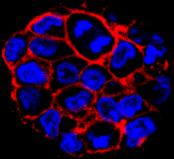Malignant rhabdoid tumor (MRT) is a rare type of childhood cancer. Its origins have been unknown until now. A recently published paper in Nature Communications, co-led by Oncode Investigator Jarno Drost in collaboration with researchers at Wellcome Sanger Institute unravels its origins. Beyond that, the study also identifies two drugs to fight it.
Malignant rhabdoid tumour (MRT) is a rare soft tissue cancer that predominantly affects infants. Although these tumours may arise in any part of the body, they usually form in the kidney and the brain. MRT is one of the childhood cancers with the poorest outcomes.
The rarity of MRT, combined with its aggressiveness, make clinical trials extremely difficult. Until now, the origin of MRT has not been known and no reliably effective treatment currently exists. This new study sought to discover the root of MRT in the hope of identifying new treatments for the disease.
“Together with our collaborators from the Wellcome Sanger Institute, we started our study by finding the cellular origin of malignant rhabdoid tumors (MRT), a very aggressive tumor of early childhood, using somatic mutations as “DNA scars” for phylogenetic analyses.’ says Jarno Drost.

According to the study, MRT arises from developmental cells in the neural crest whose maturation is blocked by a genetic defect. The analyses confirmed that MRT develops from progenitor cells on their way to becoming Schwann cells, a cell type found in the neural crest, due to a mutation in the SMARCB1 gene. This mutation blocks the normal development of these cells, which can then go on to MRT. ‘‘Having defined the neural crest as the origin of MRT, we used patient derived MRT organoids in combination with single cell transcriptomics to find the differentiation block underlying tumor development’ adds Drost.
The team then identified two drugs that could be used to overcome this block and resume normal development, bringing hope of new treatments for the disease. ’We found agents that could be used to overcome this differentiation block, pushing tumor cells back into their normal differentiation trajectory. We hope that with our findings we will contribute to better outcomes of children with these deadly tumors’.
Read the full article here